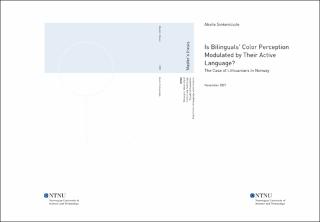| dc.description.abstract | Previous research has shown that having a different number of basic color terms across languages modulates speakers’ color perception. Speakers of languages that have two labels for two color tones (e.g., sinyj and goluboj for dark and light blue in Russian) reveal a color category effect: they discriminate between these tones faster when they fall into two categories (one light blue and one dark blue) as compared to when they are from the same category (i.e., both dark blue). On the contrary, speakers of a language that has one basic color term for both of the tones (e.g., blue in English) discriminate the same part of the blue color continuum at the same speed. Basic color terms in Lithuanian and Norwegian divide the blue color spectrum differently. Norwegian, similarly to English, only has one basic color term for blue – blå, while Lithuanian, similar to Russian, has two basic color terms: žydra “light blue” and mėlyna “dark blue”. The first aim of the current study was to examine whether experience with Norwegian can modify the color category effect in Lithuanian speakers of Norwegian (LN). Additionally, the previously reported color category effect in Russian speakers (Winawer et al., 2007) was expected in Lithuanians who live in Lithuania (LL), while Native Norwegians (NN) acted as a control group. LN participants self-reported being proficient in and exposed to their second language, Norwegian, in a variety of daily situations. A speeded color-matching task of blue stimuli that spanned the žydra/mėlyna boundary was employed to investigate color perception’ differences between the three groups. In addition, one more color matching task was performed with verbal interference in Lithuanian for LL, in Norwegian for NN, and in both languages for LN to assess the role of the activated language in color perception. In line with previous research in Russian speakers (Winawer et al., 2007), we found that LL displayed a color category effect, while NN speakers tested on the identical stimuli did not show the same effect. Moreover, our results revealed that language in which the verbal interference task was performed affected color matching for LN. When the dual task was in Lithuanian, they showed the category effect like LL. However, when the same task was performed in Norwegian, LN did not show any categorical effect. These results demonstrate that (i) color categories in native language affect performance in a color matching task and that (ii) color matching is affected by bilinguals’ activated language, with the color category effect being attenuated when second language is activated. | |
